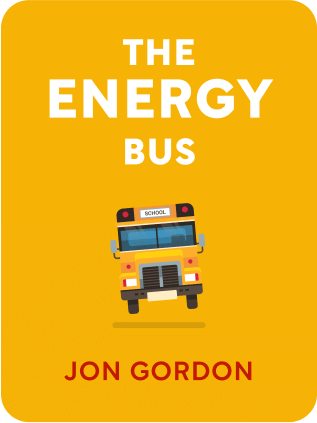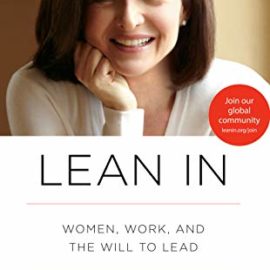

This article is an excerpt from the Shortform book guide to "The Energy Bus" by Jon Gordon. Shortform has the world's best summaries and analyses of books you should be reading.
Like this article? Sign up for a free trial here .
What are the 10 rules from The Energy Bus? What can George’s story teach you about the power of positivity?
The Energy Bus tells the fictional story of George, a depressed middle manager at a lightbulb manufacturing company, whose negativity is ruining his career and marriage. When George encounters an ebullient bus driver things begin turning around, with the help of 10 simple rules.
Find an in-depth guide to the 10 rules from The Energy Bus below.
The Energy Bus: 10 Rules for a Better Life
George was a gloomy middle manager for NRG Company, which manufactured light bulbs. He had the things many people want: a nice house, new cars, a family, and a job that paid well. However, over the years, he’d grown negative and discouraged.
At the start of yet another joyless work week, George had car trouble and had to take the bus to work. As he climbed on bus #11, the ebullient driver named Joy greeted him with a huge smile.
She immediately recognized George’s type: overstressed and zombie-like, lacking in energy, spirit, and purpose.
As George grumbled in response, she told him hers was no ordinary bus—it was “The Energy Bus”—and he was going to enjoy the ride. She was an “energy ambassador,” whose mission was to energize her passengers with positive thinking.
She told George she had a feeling he was on her bus for an important reason; he replied that the reason was car trouble. Undaunted by his grumpiness, Joy quoted author Richard Bach: “Every problem has a gift for you in its hands. You can choose to see the curse or the gift.”
Which you choose determines whether your life is a success or an ongoing drama or soap opera, she said, adding that he seemed to be making the wrong choice. She dropped him off at work with the parting words, “Choose wisely.”
After work, George got bad news from the car mechanic. The brakes were worn out and it would take two weeks to get a part they needed. The car problem felt like the last straw. The previous evening, his wife had told him his negativity was making her miserable and if he didn’t change, she would leave. At work, where he used to be a rising star, his team was falling apart, productivity was slipping, and he was in danger of being fired. He’d hit rock bottom and knew he had to change somehow.
Finally, his boss and his wife both gave him ultimatums: shape up or face losing his job and his marriage. With his life in disarray, he needed to pull together his floundering team at work for the introduction of a new lightbulb, on which his and the company’s future depended.
The next day, as George headed once more for the bus stop, he realized Joy was right: his life was a soap opera.
Joy was elated when George told her he’d be riding her bus for the next two weeks. While he viewed this as another problem on his ever-growing list, she was excited about the opportunity to share her 10 rules for living—one each of the next 10 days—which she said would change his life from a soap opera to a joy.
Since he didn’t have a better idea and needed to do something, George agreed to hear the rules. Joy pointed to a sign at the front of the bus, which listed her principles for having “the ride of your life,” the bus ride being a metaphor for life.
The Energy Bus: 10 Rules List
1. You’re the driver
2. Use vision and focus to set your direction
3. Power your bus with positive energy
4. Share your vision and Invite people on board
5. Don’t waste effort on those who don’t join you
6. Ban “energy vampires” from your bus
7. Be enthusiastic: it attracts and energizes others
9. Have a larger purpose
10. Enjoy your ride
The 10 Rules, Explained
Find an in-depth guide to each of The Energy Bus 10 Rules below.
1) You’re the Driver
The first rule of the10 rules from The Energy Bus is to realize that you’re in control of your own life.
Realizing you’re in the driver’s seat is the most important principle, Joy said, because if you don’t take responsibility for your life (drive your own bus), you can’t go where you want to go. Someone else will set your course.
As Joy was explaining this, George remarked that other people, like his boss and his wife, seemed to be making most of his decisions for him. The power of choice is your greatest gift, Joy said. When you claim it, everything starts to change.
You create your life—it’s your bus, you’re in the driver’s seat, and you determine what kind of ride it will be. Once you take the wheel of your bus, or take control of your life, you need to develop a vision for where you want to go. Ask yourself: “What’s my vision for my life?” ”What’s my vision for my work and team?” “What’s my vision for my relationships?” Write down your vision.
2) Use Vision and Focus to Set Your Direction
Turning your vision into reality starts with focusing your thoughts on it. There’s a law of energy (also known as the Law of Attraction), which says that by thinking about something, you attract it into your life.
Simply put, thoughts are magnetic, Joy said. So she instructed George to focus on his visions for at least 10 minutes each day and visualize himself creating the results he wanted—for instance, revitalizing his marriage or uniting his team at work. Athletes often use this technique to visualize winning performances.
However, she noted that because thoughts attract like energy, it’s important to focus your thoughts on what you want, rather than what you don’t want or are afraid will happen because you don’t want to attract the negative. And don’t be a complainer because complaining brings you more things to complain about. It also uses up mental energy that you could spend creating what you want.
George didn’t have a better idea so he decided to give visualization a try. The new lightbulb launch was looming.
3) Power Your Bus With Positive Energy
While vision and focus point your bus in the right direction, positive energy is the fuel that powers it. Positive energy is high-octane fuel, as opposed to the sludge created by negative energy. You need to drive your life with positive energy if you want to be successful. Negativity will fill any void, so create positive thoughts and feelings, and take positive actions so there’s no room for anything negative. Positive energy will also get your team on track too, but you have to have it yourself before you can share it.
George decided to take a Thank-You Walk around his building, citing things he was thankful for. Being thankful eliminated his stress because your body can’t be thankful and stressed at the same moment. Being grateful released endorphins and walking added even more energy.
He also read a story about golf, which pointed out that, after playing, golfers don’t think about their bad shots—instead, they focus on the one great shot they made. The good feelings make them want to keep playing and can make golf addicting.
In contrast, many people go to bed thinking about everything that went wrong that day. Instead, treat regular life like golf and savor a success each day that makes you look forward to more successes.
That evening, inspired by the golf story, George asked each of his children at bedtime to tell him their success of the day; they responded enthusiastically. Then he took the dog for a walk and thought about a success of his own: his boss had detected something different about him and told George: “Whatever you’re doing, keep doing it.” Whether you have positive or negative energy, people notice, George thought.
His next steps were sharing his vision with his team at work and inviting people to get on his bus.
4) Share Your Vision and Invite People on Board
George needed to generate positive energy for the new-product launch by getting his team on board and headed in the same direction.
Joy directed George to an Energy Bus website where he could generate “bus tickets” for inviting people on board, and email or hand-deliver them to his team members along with a message explaining his vision and expectations for the team. As Joy explained, you not only need to invite people to join you—you must tell them where you’re going and how you plan to get there so they know what they’re signing up for.
George’s plan for the day, Friday, was to:
- Meet individually with each person and share his vision.
- Give each person a bus ticket with the instructions: now that you know where I’m going, return the ticket by Monday at 9 if you’re ready to get on board.
As a leader, you need to get your team on board and headed in the same direction. To do this, meet with each team member and share your vision and expectation that each team member will contribute positively. Then invite them to join you. To underscore their commitment, you can also email or print out bus tickets from The Energy Bus website and ask them to return their ticket to you when they’re ready to get on the bus.
5) Don’t Waste Effort on Those Who Don’t Want to Join You
On Monday, George felt a nervous excitement as his employees began handing in their tickets, indicating they wanted to get on board. Most of them were eager to join the effort. However, there were a couple of surprises.
The first was that Tom and Larry, who were usually difficult to work with, joined the team. He’d expected them to reject the invitation. Three others—Michael, Jaime, and José—walked in together without tickets and told him they weren’t participating. Speaking for the trio, Michael told George they believed the new-product presentation would be a failure and they didn’t want to be part of it.
After they left his office, George felt discouraged.
The team meeting that day went badly, with Tom and Larry fighting with each other and the three others undercutting him at every turn.
Don’t waste energy worrying about people who don’t share your vision or on trying to change their minds. There will always be people who don’t want to ride your bus, or be part of your team. Don’t take it personally—maybe another bus would be a better fit for them, or they’d be a disruptive presence on your bus anyway.
6) Ban “Energy Vampires”
George got on the bus the next morning feeling discouraged, with only four days left before the new-product presentation. Joy told him that everyone faces tests and setbacks; the important thing is to keep getting up when you’ve been knocked down, like Rocky in the movie. You’re not a failure until you quit trying.
George’s three “wolves” weren’t the problem, as much as the negativity they represented, she said. Negativity surrounds us.
George agreed not to waste energy on his three “wolves” who rejected his invitation—however, he still had to do something about the two troublemakers, Tom and Larry, who were already on his bus.
This was where Rule #6—ban ‘energy vampires’—came in, Joy told him.
Joy advised George to tell Tom and Larry that they needed to contribute positively or be fired. He needed to meet with the three naysayers too, she said. Give them one more opportunity to accept the invitation; if they refuse, then isolate and exclude them from team activities and communications.
The people you surround yourself with have a big impact on whether you succeed. Some people increase your energy and your team’s energy, and some people sap it. The latter are energy vampires, who will suck the life out of you and your projects if you allow them to. They’ll make everyone else miserable and even sabotage your bus.
You need to eliminate any negativity—including negative people—standing between you/your team and your goals. That means refusing to tolerate negativity: make clear to everyone where you’re going, that you need a positive team, and that anyone who’s negative is off the project. If the naysayers don’t change, kick them off your team.
Before dropping George off at his office, Joy explained an energy principle, which she called the ultimate rule of positive energy: To succeed, your positive energy must be stronger than anyone’s negativity.
7) Be Enthusiastic: It Attracts and Energizes Others
George remembered how enthusiasm had helped him get his first job—the interviewers had loved his fire. Similarly, his enthusiasm won over his wife when he first met her and tried to get her to go out with him.
Somehow, he’d lost the enthusiasm he felt in his early days at NRG Company. He realized his team was floundering because he was projecting negative energy. Joy noted that negative people create negative corporate cultures, while positive people do the opposite.
Joy explained to George that to boost his team’s energy, he needed to broadcast his positive energy by tapping into the power of his heart. You lead from the heart by becoming the CEO, or chief energy officer of your workplace, she said.
You need to project energy in order to succeed personally and professionally. Without it, you can’t inspire or lead others. Successful people are CEOs, or chief energy officers. They exude positive energy, optimism, and excitement about their lives and work. They aren’t discouraged by challenges, but welcome them as opportunities to grow.
Enthusiasm comes from the Greek word entheos, which means inspired or filled with the divine. When you bring this level of inspired energy to everything you do, others feel it and want to be on your team.
8) Show You Care About Your Team
As a starting point, Joy suggested that George focus on bringing out the best in each member of his team; he should help them discover the inner value they possess.
Part of caring is bringing out the best in others, or helping them to shine. When a manager discovers and allows employees to use their strengths, the individual’s and team’s value increase.
To inspire others, you also need to become a “love magnet” by demonstrating caring and commitment to your family, company, employees, and customers. While it sounds trite, the truth is that what everyone wants most is to be loved. Your employees want your love too. You can give them awards, gifts, and raises, but these are soon forgotten. What sticks with them is a sense of whether you really care about them and are committed to their future. When they know you care about them, they respond in kind by being loyal and doing great work. In contrast, if you treat them as just a means to your next promotion, you’ll get cynicism in return.
9) Have a Larger Purpose
Purpose is the most important fuel additive for your journey. Knowing your purpose keeps you energized and focused and prevents burnout. For instance, Joy saw herself not only as a bus driver, but also as a life coach, helping people find their energy and change their lives. This gave her a sense of purpose that inspired her and her passengers. Purpose infuses your everyday life with passion.
Many companies and their employees lack this kind of spirit. Their cultures kill people’s energy and spirit, resulting in low morale, negativity, and poor retention and performance. While big projects can be inspiring, companies need to create lasting energy. Joy advised George to find the bigger purpose before the product launch and let it fuel and continue to carry the team after the launch.
As George wondered how to get people excited about lightbulbs, he found another page to the letter, which told a story about two airplane design teams. One team was given a mission to build the world’s most advanced airplane and was shown a model of the aircraft. The other team was divided into small groups and each group was given a component to design; the subgroups weren’t given an overall mission or shown a model of the end product. The team with a mission and vision of the airplane worked twice as long and hard and finished in half the time as the other group. This gave George an idea.
They settled on three core principles. They would not only bring new lightbulbs to the market, but also:
- Strive for greatness—great ideas, marketing, and results.
- Work with purpose and energy. Develop chief energy officers within their team and the company.
- Make lightbulbs that warm and brighten people’s lives. For instance, their lightbulbs would help children read, help elderly people avoid falling at night, and help people get ready for work. Everyone who flipped a switch would benefit from the light Goerge’s team created.
Discovery of their purpose transformed the team members. Infighting stopped as they focused on contributing to something larger than themselves. They embodied positive energy. That final night before the presentation, every member of the team worked late with George to finish it.
10) Enjoy Your Ride
George hoped Friday would be a new beginning and a new opportunity that would allow him to share the principles he had learned on the energy bus. Even though he’d been up working until 2 a.m., he felt energized. His wife had noticed a big difference in him—for instance, she said that he complained less, showed his love by spending more time with the family, and was positive and enthusiastic. She felt she’d regained the man she’d married and their marriage was back on track. So even if the presentation flopped, at least he had his family.
Joy commented that you succeed when your trust is greater than your fear. George should go into the meeting focused on his blessings rather than stresses. Among his blessings were: having a job, having a supportive family and team, having friends, and being healthy.
Similarly, you can use the 10 rules from The Energy Bus to consider what you have to be grateful for.
George and his team proceeded to deliver one of the best product launches in the company’s history. The leadership had been prepared to fire him, but now they were on his bus. They asked him what had changed. He responded that he’d decided to stop being just a manager and be a chief energy officer. Since his job was now assured, he’d have time later to explain what that meant.
In appreciation, he told his team they could take the rest of the day off, but no one wanted to leave—they wanted to celebrate together. So instead, he invited them all to lunch, where they began laying plans for future successes. They were excited about where their bus was going.
Since we have only one life, we should enjoy it. Often, people spend their lives stressing over small or unimportant things—for instance, emails, deadlines, arguments, and trivial inconveniences—and overlook the beauty around them. But on the day you die, you’ll still have a pile of unopened emails. So don’t worry about such small things—focus instead on finding joy in each moment. Live each day with purpose and joy.
The above 10 rules from The Energy Bus can be applied to your own life, offering improvements in your career, relationships, and well-being.

———End of Preview———
Like what you just read? Read the rest of the world's best book summary and analysis of Jon Gordon's "The Energy Bus" at Shortform .
Here's what you'll find in our full The Energy Bus summary :
- How to turn things around when you feel unmotivated and discouraged
- The 10 rules for reenergizing your life through positive thinking
- How to build successful teams at work and improve your relationships







I am so thankful that I went through some old notes and found the title: The Energy Bus ; by Jon Gordon. It has enriched my life this morning, and now l am ready to brush off my dream, and go make it happen for me. I am the driver you know!
Hi. This helped me in my project.